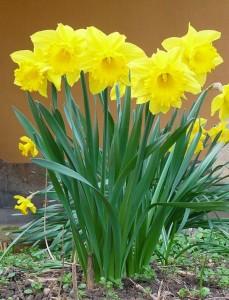Plant Fall Bulbs Now for Spring Color!
go.ncsu.edu/readext?187986
en Español / em Português
El inglés es el idioma de control de esta página. En la medida en que haya algún conflicto entre la traducción al inglés y la traducción, el inglés prevalece.
Al hacer clic en el enlace de traducción se activa un servicio de traducción gratuito para convertir la página al español. Al igual que con cualquier traducción por Internet, la conversión no es sensible al contexto y puede que no traduzca el texto en su significado original. NC State Extension no garantiza la exactitud del texto traducido. Por favor, tenga en cuenta que algunas aplicaciones y/o servicios pueden no funcionar como se espera cuando se traducen.
Português
Inglês é o idioma de controle desta página. Na medida que haja algum conflito entre o texto original em Inglês e a tradução, o Inglês prevalece.
Ao clicar no link de tradução, um serviço gratuito de tradução será ativado para converter a página para o Português. Como em qualquer tradução pela internet, a conversão não é sensivel ao contexto e pode não ocorrer a tradução para o significado orginal. O serviço de Extensão da Carolina do Norte (NC State Extension) não garante a exatidão do texto traduzido. Por favor, observe que algumas funções ou serviços podem não funcionar como esperado após a tradução.
English
English is the controlling language of this page. To the extent there is any conflict between the English text and the translation, English controls.
Clicking on the translation link activates a free translation service to convert the page to Spanish. As with any Internet translation, the conversion is not context-sensitive and may not translate the text to its original meaning. NC State Extension does not guarantee the accuracy of the translated text. Please note that some applications and/or services may not function as expected when translated.
Collapse ▲Planting bulbs this fall is an easy way to guarantee a splash of color for your spring landscape. November through December is the appropriate time to plant spring blooming bulbs in our region, but some varieties are a better investment than others.
Recommended Varieties
Not all bulb varieties can be counted on to come back year after year. In addition to daffodils, the most reliably perennial spring blooming bulbs for our climate are Spanish bluebells (Hyacinthoides hispanica), with spikes of white, blue or pink blossoms that open the same time as azaleas; summer snowflake (Leucojum aestivum), whose dainty spikes of white bell shaped flowers resemble lily of the valley and open in April; and starflower (Ipheon uniflorum), a low growing, early bloomer with icy blue, star shaped blossoms. In addition to being perennial, these bulb varieties are rarely bothered by deer or rabbits.
When it comes to daffodils, all types are not equally reliable. If you are looking for a classic large flowered yellow daffodil that will return and multiply for years to come, plant ‘Carlton’ or ‘St.Keverne’. For a splash of yellow very early in the season, try ‘Febuary Gold’ or ‘Jack Snipe’, both of which bloom in February and are shorter than later blooming varieties. Also dependable are the varieties sometimes referred to as jonquils, which bear fragrant clusters of small flowers resembling paperwhites. Recommended selections include ‘Sweetness’, ‘Quail’, ‘Baby Moon’, ‘Minnow’, ‘Geranium’, and ‘Avalanche’.
Other spring blooming bulbs can be counted on to come up and bloom the spring after they are planted, but are less likely to return year after year. Some will come back and bloom for three or four years before dying out, and may occasionally last longer when planted in perfect conditions. These include the many types of ornamental onions (Allium species), Dutch and grape hyacinths, anemones, Dutch iris, and Persian buttercups (Ranunculus).
Other bulbs should be thought of as annuals, providing color for just one spring, and if they do come back a second or third year consider it a bonus, but do not expect it. Bulbs in this category include tulips and crocus, which are favorites of deer, snowdrops (Galanthus), dwarf iris (Iris reticulata), and several types of early blooming, low growing bulbs with white or blue flowers that are commonly referred to as squills (Scilla, Chionodoxa, and Puschkinia).
Using Bulbs In the Landscape
For high impact, plant bulbs in solid masses or large sweeps. To add color and interest to existing beds and borders, tuck bulbs between perennials and deciduous shrubs, where they will bring early color to otherwise dormant areas. Bulbs also work well when planted underneath winter annuals such as pansies and violas, creating a layered effect when they come up to bloom in spring. Similarly, fall bulbs can be tossed into container plantings to add a new dimension of interest in spring.
All bulbs prefer to grow in well drained soil, except summer snowflake, which grows quite happily in heavy, moist soil. In addition, bulbs perennialize well in sunny areas and under deciduous trees. A general rule of thumb for planting bulbs is to set them at a depth two to three times the size of the bulb; This means small bulbs are only planted 3” to 4” deep, while larger bulbs like daffodils are planted at a depth of 8”. A slow release or organic fertilizer can be worked into the soil at planting time or applied in spring when bulb leaves begin to emerge. After planting, cover the soil with mulch to moderate soil temperatures and prevent weeds from coming up.




